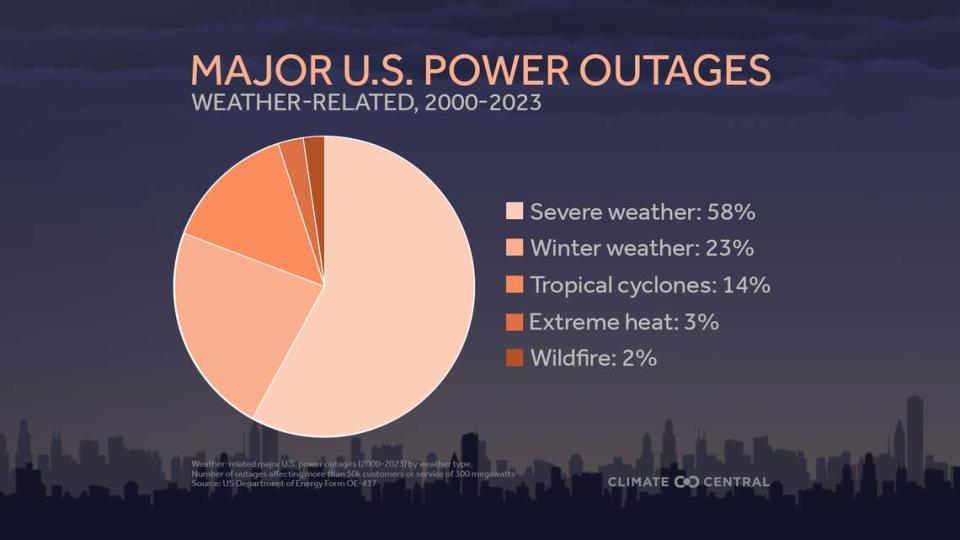How at-risk is Boise of major power outage from severe weather? Here are the numbers
As a wide array of extreme weather events, from hurricanes to heatwaves, increasingly batter the United States, the nation’s aging energy infrastructure is progressively more strained.
According to data compiled by the non-profit Climate Central, 2,194 major power outages have been reported to the U.S. Department of Energy since the start of the 21st century. A major power outage is considered to affect 50,000 customers or interrupt the service of at least 300 megawatts of power, Peter Girard, vice president of communications at Climate Central, told the Idaho Statesman.
Of those 2,194 major power outages, 80% (1,755) were due to weather-related incidents; 58% were due to severe weather, 23% from winter storms and 14% from tropical cyclones or hurricanes.

Idaho isn’t known for its severe weather — in fact, the state is among those that receive some of the least severe weather events nationwide. Since 1980, Idaho has only had a single billion-dollar weather disaster, when a heatwave ravaged much of the western U.S. during the summer of 1988.
“The mountains wring out the precipitation,” Jay Breidenbach, a meteorologist with the National Weather Service in Boise, previously told the Idaho Statesman.
“So if we get a big storm that comes through Idaho, it first has to pass usually through Washington, Oregon or Northern California,” he continued. “And there are numerous mountain ranges between here and the coast.”
Power outages in Idaho
However, severe weather events resulting in significant power outages occasionally occur in the state.
Since 2000, Idaho has reported 11 major power outages to the U.S. Department of Energy. Six were weather-related, all caused by severe weather, such as thunderstorms or wind. For comparison, other states like Hawai’i have reported power outages because of lightning or earthquakes.
According to data from Climate Central, the most recent significant power outage in Idaho occurred on June 27, 2023, due to an unexpected transmission loss that also affected Montana and Washington.
The last major power outage in the state due to severe weather was on Jan. 13, 2021, after high winds toppled trees in northern Idaho, leaving individuals in the Coeur d’Alene and Spokane, Washington, regions without power for multiple days.
Perhaps unsurprisingly, due to Idaho’s low ranking for severe weather events, the whole northwestern part of the county — Idaho, Washington and Oregon — has only experienced a total of 73 weather-related outages since 2000, according to Climate Matters. That total ranks third-lowest for any region in the country, only more than the southwest (28) and the northern Rockies and plains (24).
The most affected region in the nation is the southeast, which has experienced 360 weather-related major outages since the turn of the century.
Preparing for a power outage in Boise
The Boise area occasionally experiences regional power outages, but large-scale outages aren’t as common. According to Idaho Power, the average Idaho Power customer is without power for less than 3 hours per year.
However, the organization still provides a checklist for customers to be prepared for a more extensive outage. Here’s what to know:
Download Idaho Power’s mobile app to sign up for outage-related notifications and immediately access the outage map.
Sign up to receive text alerts from Idaho Power.
Prepare for medical needs that need power, such as refrigerated medicine and electrically-powered medical equipment. One solution is purchasing a backup power generator or having somewhere you can go if there is an outage.
Be prepared to have a way to feed and water pets, service animals or livestock in case water pumps don’t have power.
Learn how to manually open security gates and garage doors.
Have the following items on hand in a kit:

